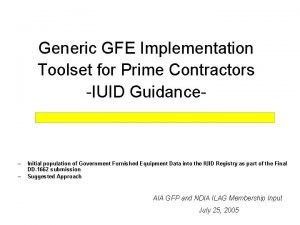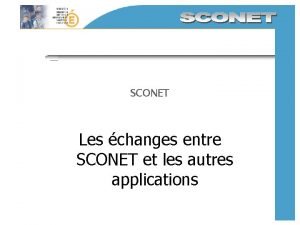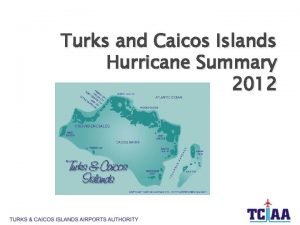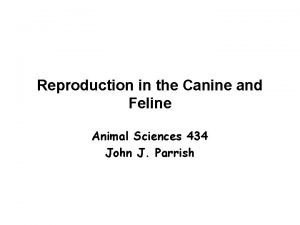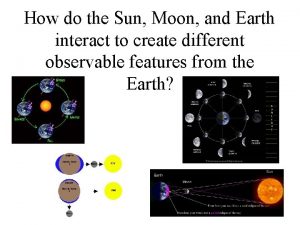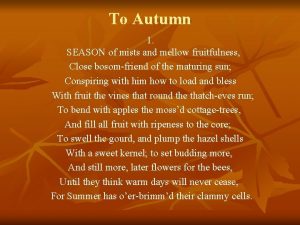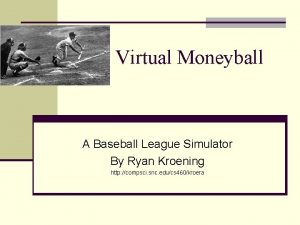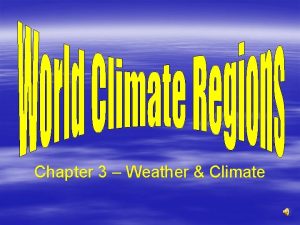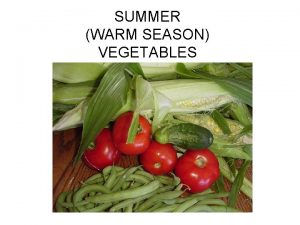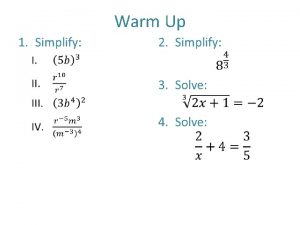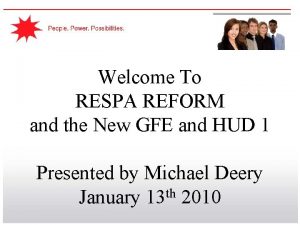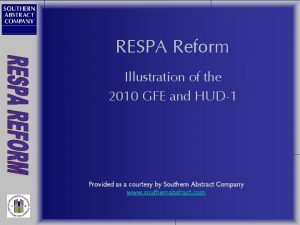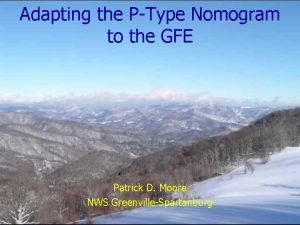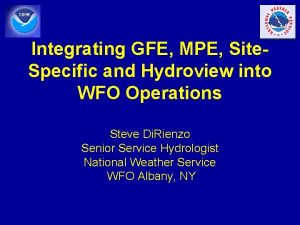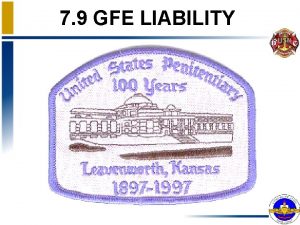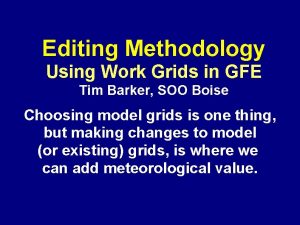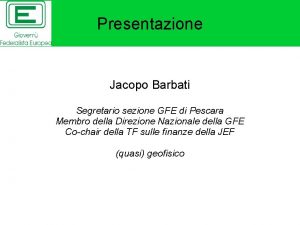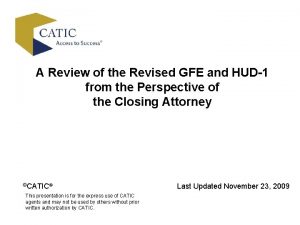Warm Season Forecasting with GFE along the Florida































- Slides: 31

Warm Season Forecasting with GFE along the Florida Panhandle Coastline - Bryan Mroczka WFO Tallahassee, FL

Outline 1. What exactly is GFE ? 2. Florida Panhandle forecast challenge in the warm season 3. Florida Panhandle sea-breeze convection research 4. Tallahassee GFE Sea-Breeze Convection tool 5. Future research

GRAPHICAL FORECAST EDITOR - GFE ? Software package used at WFOs to produce graphical forecasts “grids” of weather elements including T, Td, Wx, Sky, Po. P, Wave. Height, QPF, etc…

The point-n-click era now allows WFOs to provide more detailed location specific forecasts by utilizing these “grids” WFO Tallahassee Point and Click interface http: //www. nws. noaa. gov/tlh

Forecast Challenge The warm season is dominated by outdoor and water related activities. - Beach - Sports - Construction - Pool Threatened daily by diurnal sea-breeze thunderstorms

“It rains every day at 3 o’clock” False statement used to describe Florida Convection Needed to improve daily Po. P forecasts using the Graphical Forecast Editor (GFE) and thus aid in outdoor planning Mon Tues Wed Thurs Fri 50% 50% 50% Not a very useful forecast !

Tallahassee Sea-Breeze Convection Research Background Info

Research began by examining “flow patterns” or “Flow Regimes” These flow regimes are classified by the position of the subtropical ridge relative our forecast area Each regime produces a unique low level flow (1000 -700 mb mean) which will interact differently with the sea breeze to maximize convergence. Typical Regime # 1 Pattern

Eleven potential regimes identified Weak and Strong flow from varying directions 1. Light and Variable 2. Light E-NE flow ( < 10 knots ) 3. Strong E-NE flow ( > 10 knots ) 4. Light W-SW flow 5. Strong W-SW flow 6. Light SE Flow 7. Strong SE Flow 8. Light N-NW flow 9. Strong N-NW flow 10. Suppressed (Strong H 5 Ridge Overhead) 11. Disturbed (Usually similar to Strong W-SW flow)

Flow Regime Climatology A rainfall climatology for each regime was produced using data over a 5 year period from 2002 through 2007 Each warm season day (June 1 st – September 15 th) was classified into one of our eleven regimes Archived radar/MPE (Multi-sensor Precipitation Estimates) data was obtained to determine which radar pixels received measurable rainfall on each day

For the days comprising each regime, the frequency in which a pixel received rainfall became a baseline Po. P for that location For example: Flow regime # 1 was seen 120 days during the time of study. A given pixel received measurable rainfall 35 of those days: 35/120 = 0. 29 or 30% A baseline Po. P of 30% is assigned to that location for Regime # 1

Po. P climatology for each Regime 11 distinct rainfall patterns

Significant differences in localized rainfall probability can easily be seen from one regime to another

Another example of the areal rainfall chances from one regime to another

A convenient method was needed to rapidly reproduce these rainfall climatologies using the GFE software

The Tallahassee Sea-Breeze Convection Tool Forecaster Interface

1. Determines the day’s flow regime 2. The tool will access saved data files for the chosen regime which represent areal coverage of each 10% Po. P interval 3. These files layered on top of one other produce a graphical Po. P forecast that matches the original climatologies

GFE produced Po. P for Regime #3 (top) and original radar based graphic (bottom)

Another Example: GFE produced Po. P for Regime # 10 (top) and original radar based graphic (bottom)


Normal CAPE and PW values for the chosen regime are coded into the tool (slider bars below the regime list) The forecaster can change these values based on local sounding data or numerical guidance If pre-determined thresholds for these fields are exceeded, the climo Po. P grid will be raised or lowered by 10% to 20 %

Additional Options The forecaster can also choose to blend the Climo Po. P grid with one or more traditional guidance packages (MAV, MET, SREF, etc…)

Basic QPF and Sky Grids can also be created to match your Po. P forecast The current “regime” option uses fairly simple algorithms - higher Po. P value results in higher sky cover and QPF More sophisticated procedures are in production for the next build of this tool

Future Upgrades to the sea-breeze tool • Develop higher temporal Po. P grids for each regime (3 or 6 hourly) • Update the tool each winter to include new data from the most recent warm season • Include ongoing cloud frequency research for each regime (GFE Sky grid)

Regime Cloud Frequency Research Brief Overview

• Thunderstorm clusters will often develop expansive anvil/cirrus canopies by the later afternoon hours which expand far from the actual storms. • Cloud frequency grids for each regime can be created for a number of temporal lengths using similar methods to the rainfall frequencies • The sea-breeze tool can then be used to re-produce these cloud frequencies into the GFE sky grids

Daily Cloud Frequencies – Regime 1 1200 Z 1500 Z 2000 Z 1800 Z 2300 Z

Areas have been discovered that have an 80% to 100% probability of cloud cover at a specific time

Climatological QPF Grids ? • QFP grids will be more difficult to produce • Warm season rainfall is highly variable over sub-grid scale distances.

Forecasts with high temporal detail can be best utilized with the hourly weather graphs. These graphs are available through each WFO homepage Hourly Weather Graphs continue to become increasingly popular with the public and other local customers

Thanks You for Listening Any question or comments?
 Gfe vs gfp
Gfe vs gfp Gfe meaning
Gfe meaning Sconet nomenclatures
Sconet nomenclatures Warm season crops
Warm season crops Tư thế ngồi viết
Tư thế ngồi viết Nothing happens twice
Nothing happens twice Summer is one season
Summer is one season Iia season 7
Iia season 7 Genre of stranger things
Genre of stranger things Hurricane season turks and caicos
Hurricane season turks and caicos Thẻ vin
Thẻ vin In which season is paddy cultivated
In which season is paddy cultivated Voi kéo gỗ như thế nào
Voi kéo gỗ như thế nào Warum feiert man fasching
Warum feiert man fasching Quá trình desamine hóa có thể tạo ra
Quá trình desamine hóa có thể tạo ra How long do dog periods last
How long do dog periods last Diễn thế sinh thái là
Diễn thế sinh thái là What season is this
What season is this Autumn is a season of mellow
Autumn is a season of mellow What is season
What is season Thế nào là hệ số cao nhất
Thế nào là hệ số cao nhất January february march april may
January february march april may What is season
What is season Thế nào là mạng điện lắp đặt kiểu nổi
Thế nào là mạng điện lắp đặt kiểu nổi Bài hát chúa yêu trần thế alleluia
Bài hát chúa yêu trần thế alleluia Thế nào là giọng cùng tên
Thế nào là giọng cùng tên Sơ đồ cơ thể người
Sơ đồ cơ thể người Roxie breeding season
Roxie breeding season Tư thế ngồi viết
Tư thế ngồi viết độ dài liên kết
độ dài liên kết Virtual baseball simulator
Virtual baseball simulator Rainy season photo
Rainy season photo
